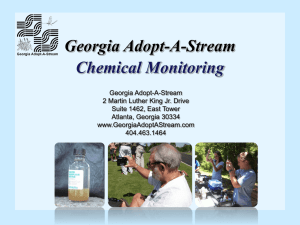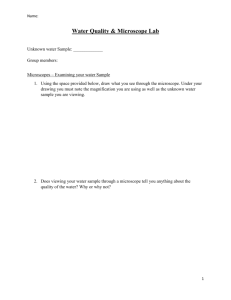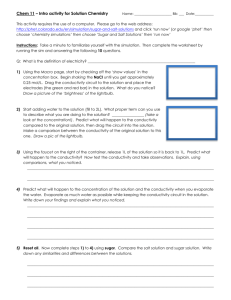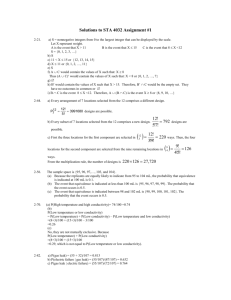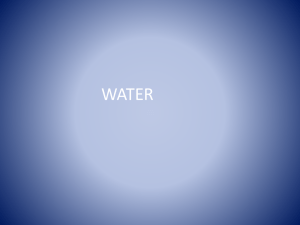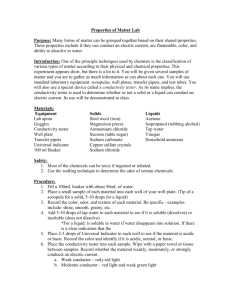Assessment of the Water Quality at 21 Acres_draft
advertisement
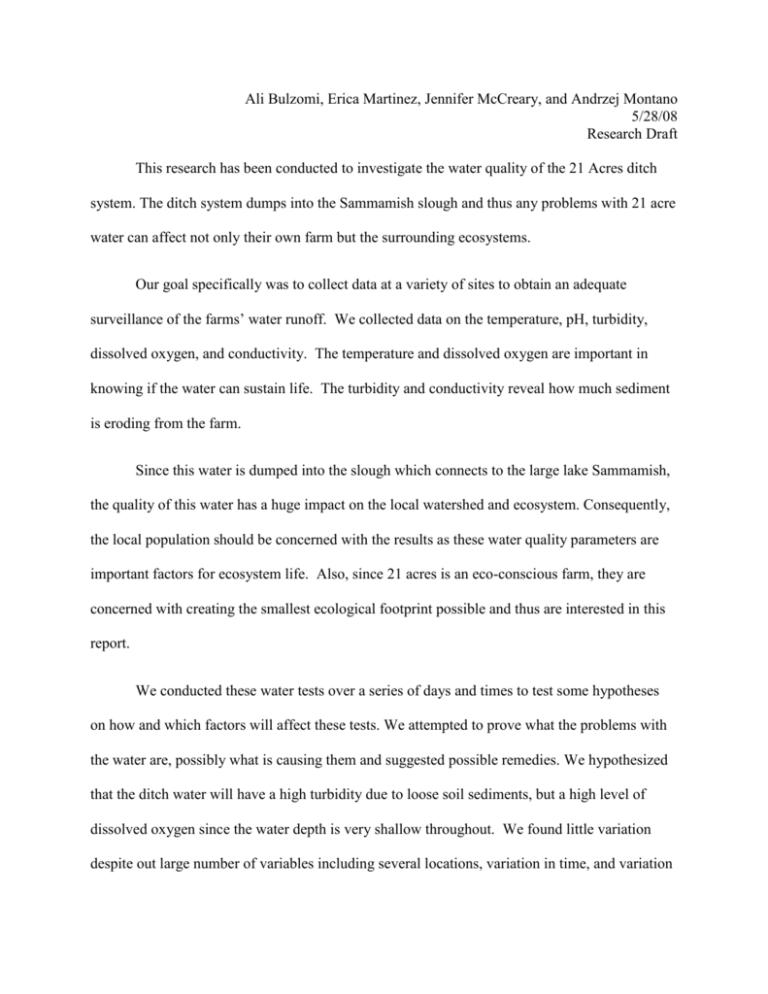
Ali Bulzomi, Erica Martinez, Jennifer McCreary, and Andrzej Montano 5/28/08 Research Draft This research has been conducted to investigate the water quality of the 21 Acres ditch system. The ditch system dumps into the Sammamish slough and thus any problems with 21 acre water can affect not only their own farm but the surrounding ecosystems. Our goal specifically was to collect data at a variety of sites to obtain an adequate surveillance of the farms’ water runoff. We collected data on the temperature, pH, turbidity, dissolved oxygen, and conductivity. The temperature and dissolved oxygen are important in knowing if the water can sustain life. The turbidity and conductivity reveal how much sediment is eroding from the farm. Since this water is dumped into the slough which connects to the large lake Sammamish, the quality of this water has a huge impact on the local watershed and ecosystem. Consequently, the local population should be concerned with the results as these water quality parameters are important factors for ecosystem life. Also, since 21 acres is an eco-conscious farm, they are concerned with creating the smallest ecological footprint possible and thus are interested in this report. We conducted these water tests over a series of days and times to test some hypotheses on how and which factors will affect these tests. We attempted to prove what the problems with the water are, possibly what is causing them and suggested possible remedies. We hypothesized that the ditch water will have a high turbidity due to loose soil sediments, but a high level of dissolved oxygen since the water depth is very shallow throughout. We found little variation despite out large number of variables including several locations, variation in time, and variation in weather conditions. Although we found some data correlations, we were unable to conclude any major claims. Site Map Figure 1. Aerial photo of 21 Acres showing the locations of sampling sites. Data was collected at sites 1, 2, 3, 4, 5, A, B, C, and D Results Table 1: Dissolved oxygen, conductivity, turbidity, pH, and temperature measurements from water samples taken from 21 Acres for all five testing dates. Table 2: Dissolved oxygen, conductivity, turbidity, pH, and temperature measurements from water samples taken from 21 Acres for testing date 5/5/08. Table 3: Dissolved oxygen, conductivity, turbidity, pH, and temperature measurements from water samples taken from 21 Acres for testing date 5/12/08. Table 4: Dissolved oxygen, conductivity, turbidity, pH, and temperature measurements from water samples taken from 21 Acres for testing date 5/15/08. Table 5: Dissolved oxygen, conductivity, turbidity, pH, and temperature measurements from water samples taken from 21 Acres for testing date 5/19/08. Table 6: Dissolved oxygen, conductivity, turbidity, pH, and temperature measurements from water samples taken from 21 Acres for testing date 5/20/08. Figure 2.1: Comparison of conductivity and temperature measurements over time at Site 1. Figure 2.2: Comparison of conductivity and temperature measurements over time at Site 2. Figure 2.3: Comparison of conductivity and temperature measurements over time at Site 3. Figure 2.4: Comparison of conductivity and temperature measurements over time at Site 4. Figure 2.5: Comparison of conductivity and temperature measurements over time at Site 5. Figure 2.6:Comparison of conductivity and temperature measurements over time at Site A. Figure 2.7:Comparison of conductivity and temperature measurements over time at Site B. Figure 2.8:Comparison of conductivity and temperature measurements over time at Site C. Figure 2.9:Comparison of conductivity and temperature measurements over time at Site D. Figure 3.1: Comparison of conductivity and turbidity measurements over time at Site 1. Figure 3.2: Comparison of conductivity and temperature measurements over time at Site 2. Figure 3.3: Comparison of conductivity and temperature measurements over time at Site 3. Figure 3.4: Comparison of conductivity and temperature measurements over time at Site 4. Figure 3.5: Comparison of conductivity and temperature measurements over time at Site 5. Figure 3.6:Comparison of conductivity and temperature measurements over time at Site A. Figure 3.7:Comparison of conductivity and temperature measurements over time at Site B. Figure 3.8:Comparison of conductivity and temperature measurements over time at Site C. Figure 3.9:Comparison of conductivity and temperature measurements over time at Site D. Figure 4.1: pH measurements over time at Site 1. Figure 4.2: pH measurements over time at Site 2. Figure 4.3: pH measurements over time at Site 3. Figure 4.4: pH measurements over time at Site 4. Figure 4.5: pH measurements over time at Site 5. Figure 4.6: pH measurements over time at Site A. Figure 4.7: pH measurements over time at Site B. Figure 4.8: pH measurements over time at Site C. Figure 4.9: pH measurements over time at Site D. Figure 5.1: Comparison of temperature and dissolved oxygen measurements over time at Site 1. Figure 5.2: Comparison of temperature and dissolved oxygen measurements over time at Site 2. Figure 5.3: Comparison of temperature and dissolved oxygen measurements over time at Site 3. Figure 5.4: Comparison of temperature and dissolved oxygen measurements over time at Site 4. Figure 5.5: Comparison of temperature and dissolved oxygen measurements over time at Site 5. Figure 5.6: Comparison of temperature and dissolved oxygen measurements over time at Site A. Figure 5.7: Comparison of temperature and dissolved oxygen measurements over time at Site B. Figure 5.8: Comparison of temperature and dissolved oxygen measurements over time at Site C. Figure 5.9: Comparison of temperature and dissolved oxygen measurements over time at Site D. Discussion As seen in figure 5.1, the temperature vs. dissolved oxygen levels should have shown a reverse correlation but instead proved to be an anomaly. The lower the temperature, the higher the dissolved oxygen should have been. In figures 2.3, 2.6 and 2.7, this perfect correlation of temperature vs. dissolved oxygen is present. Our group encountered several challenges while conducting research at the farm 21 acres. Our pH meter stopped working suddenly in the middle of a field work trip out to 21 acres. One day construction on a bridge in our exact testing location had begun and we were unable to test the location. We had anticipated on testing urban runoff water collected in bottles but there never was a sufficient amount to test, giving us no data for the site. On one of our outings it was raining so hard that even taking notes was made incredibly difficult. The only solution was to record data on a cell phone. Many machines never gave a steady reading. They were often varying within a small margin but that still leaves open the opportunity of error. Finally, due to scheduling issues within the group, we were only able to meet at 3 different times of day which may have prevented us recording the full variability. Despite these problems, we are confident in our results. For further work, in order to confirm and legitimize our current results, we would continue collecting data but with an increased variability in the times and weather conditions at the time of collection as well as increasing the number of sights and collecting water samples during rainfall to ensure urban runoff data.
